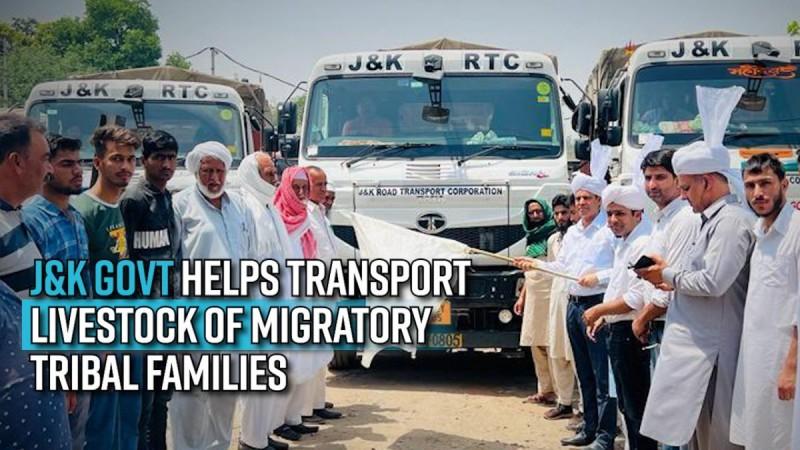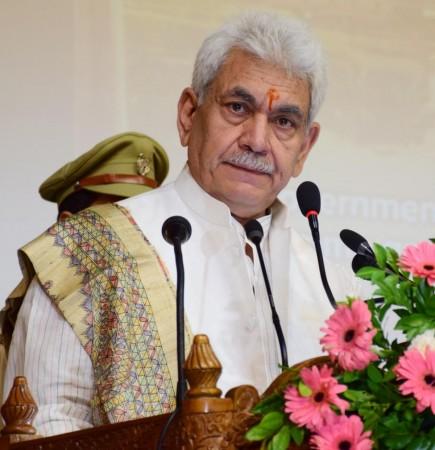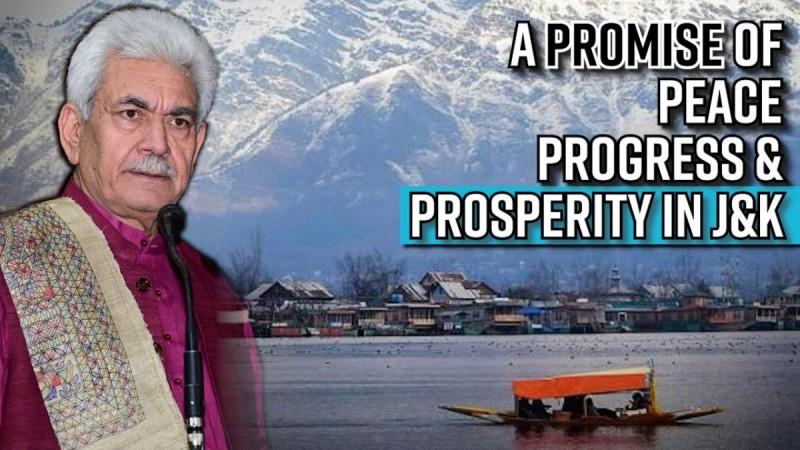August 5 marks the completion of three years since the abrogation of Article 370, 35-A, which scrapped the erstwhile state's so-called special status. These three years have been the most remarkable years in J&K's development and in terms of restoring peace and prosperity in the Valley. But that's not it. Several government initiatives have been effectively executed to benefit the common people. Right from education to power reforms and job creation to good governance, the J&K government has left no sector stale.
Here's a look at how the abrogation of Article 370 has marked the dawn of a new era in J&K.

Good governance all the way
J&K managed to put an end to misgovernance by ensuring unprecedented transparency in financial management. To that effect, the government ensured the entire budget allocation is made online via Budget Management Application -BEAMS; no execution of works without administrative approval and e-tendering; 100% physical verification and GEO tagging of works with pre and post-execution photographs; and transparent and rule-based procurement.
J&K also adopted JKPaySys -an Online Billing System adopted across the UT. Jammu and Kashmir also became the first ever State/UT to devise a comprehensive District Good Governance Index (DGGI). In the Good Governance Index 2021, J&K registered an overall increase of 3.7 percentage points over GGI 2019. It performed strongly in the commerce & industry sector and improved its score in agriculture & allied sectors; public infrastructure and utilities and judiciary & public safety.
As a result, in the last three years, the number of developmental projects completed doubled year on year.
Power sector reforms
The central government has taken proactive steps and provided liberal funding that has put J&K on the path of becoming self-reliant vis-a-vis power generation. Right from sanctioning phase-I package of Rs 5641.91 crore for a complete revamping of the power distribution infrastructure under Revamped Distribution Sector Scheme (RDSS) in both urban and rural areas of J&K to achieving last mile connectivity and 100 per cent saturation of the Central Sector Scheme of Universal Household Electrification, J&K's power sector reforms have benefitted the common people.

Abrogation of the so-called J&K's special status changed the entire scenario. Union Minister of State (MoS) Dr. Jitendra Singh recently said that the Union government is working towards making electricity free in Jammu and Kashmir in the next 4-5 years by installing solar plants.
J&K becomes the new investment destination
The J&K administration has worked against the odds here. All the efforts are paying off now as J&K has become the new investment destination. The UT administration has received Rs 52,000 crore worth of investment proposals, which holds a potential of 2.37 lakh jobs.
The only way the government has achieved these milestones is with a give-and-take policy. By giving the promise of incentives, ease of doing business and reducing regulatory compliances, businesses feel welcomed in the valley.
The recent visit of J&K LG Manoj Sinha to Dubai Expo-2020 yielded remarkable outcomes. MoUs worth Rs 3000 crore are in the pipeline from Dubai Expo alone.
Besides, 39 MoUs worth Rs 18,300 crores have been signed for the development of Real Estate in Housing, Hospitality, Industries, Warehousing, Film, and Entertainment. A Medicity with 6000 bedded hospitals is also coming up. A high-level delegation of 35 entrepreneurs from the Gulf countries has explored investment opportunities in J&K.
Unwavering focus on health
While the COVID-19 pandemic exposed the loopholes in the healthcare systems globally, J&K worked tirelessly to revamp its health infra and deliver world-class care. With an investment of Rs 7,177 crores, the J&K administration set up 2 new AIIMS, 10 new nursing colleges, 2 state cancer institutes, 7 new medical colleges, and 5 nursing colleges were upgraded. J&K has one of the highest budget allocations for health in India, which proves its priority. The government has reserved Rs 881 crore for the upgradation of district infrastructure. Having completed 108 projects, 32 more are to be completed in 2022-23.

J&K also set an example of tackling the COVID-19 pandemic. It led in the vaccination drive by achieving 100 percent inoculation for 18 years and above with both doses and 100 percent coverage for population of age group 15 -18 years of age with the first dose.
The PM Cares benefits were extended to the people of J&K, including Rs 10 lakh corpus for a child orphaned due to COVID, sanctioning 418 pension cases and 414 scholarships, health insurance of Rs 5 lakh under Ayushman Bharat scheme and SASCM benefits for the masses.
Guiding youth through education
The J&K Government has spent considerable time and effort in the educational sector, through which it has managed to curb the insurgency and nudge the youth towards productive avenues like education and skill development. The government runs a great number of Centre and state-supported schemes, especially to emancipate the backward, marginalised, disadvantaged and underprivileged sections of society so that they are not deprived of education. It includes providing free education up to the college level, mobile institutions for the nomadic population, scholarships, and free books and uniforms to deserving students.

There are two new AIIMS, seven new medical colleges, two State cancer institutes and 15 nursing colleges that have been set up and operationalised recently. The intake capacity of 854 seats was added, which includes 600 MBBS, 50 PG courses, 26 BDS, 38 MDS and 140 DNB. Indian Institute of Technology (IIT) Jammu and Indian Institute of Management (IIM) Jammu have also been made functional. The number of government degree colleges/engineering colleges has increased from 96 to 147.
With the renewed emphasis on the skilling, reskilling and upskilling of the youth of the region, the Government has been able to create jobs that did not exist earlier. With rising education rates and possible opportunities, the youth would find themselves incentivised to create a better future for themselves, their families and their children further ahead.
Farmers taste real benefits
Jammu and Kashmir has been ranked third in monthly income of agricultural households and fifth best performing State / UT in Agriculture & Allied Sectors. This is a result of various schemes launched to benefit the farmers and boost agriculture in the UT. The PM KISAN scheme reached 100 percent saturated as Rs 1975.29 crores were credited directly into Bank accounts of eligible farmers of J&K till Jan 31, 2022. Kisan Credit Card coverage was increased from Rs 7.50 lakh to Rs 12.7 lakh. Over 4,000 panchayats were given One Paddy thresher for free.

Implementation of National Saffron Mission resulted in an increase in the crop yield from 1.88 kg/Ha to 4.5 kg/Ha, which has doubled the income of saffron growers.
Mission youth
Mission youth has been one of the most rewarding initiatives on behalf of the J&K administration. The valley takes pride in organising the largest ever recruitment drive in its history while ensuring fair and transparent selection process. By choosing the path of 100 percent recruitment on merit, the administration has given equal and fair opportunities.
![New Hope: Panchayat level youth clubs in J&K; LG orders key SOPs for youngsters [details here]](https://data1.ibtimes.co.in/en/full/762503/new-hope-panchayat-level-youth-clubs-jk-lg-orders-key-sops-youngsters-details-here.jpg?h=450&l=50&t=40)
The government has also given special consideration to disadvantaged categories - such as widows, divorced women, judicially separated women and orphan girls. A multi-pronged strategy has been adopted with a focus on livelihood generation, education and skill development, counselling, financial assistance, sports and recreation in the Valley. A specialized program was also launched to inspire & train the youth of J&K to join the Armed Services of the country. In its first phase, 3,500 youth got trained.
Under the Mission Youth program, many initiatives including Mumkin, Tajeswani, Youth Volunteer Program, District Youth Clubs, Super 75 & SuperB 75, AVSAR, Parvaaz and more flourished. Liberal funding was provided to strengthen J&K's tourist village network.
Empowering women
Treating daughters of J&K at par with the men was the first step towards empowering women in the newly carved out Union Territory of Jammu and Kashmir. Women have been provided with wings to chase their dreams and they have proven their mettle by the dint of their hard work and sheer determination.
After August 5, 2019, more than 5 lakh women have become financially independent in J&K through the Self Help Groups initiative. For the first time in 70 years, J&K Police reserved a 15 per cent quota for women in non-gazetted cadre. The countless women empowerment schemes and the reforms introduced by the government to identify their potential in the leadership role and provide them with the opportunity to scale up their businesses have changed their lives in 'Naya J&K'.

In 'Naya Jammu and Kashmir' women have become equal stakeholders in every field. They are no longer treated as commodities or in any way less than men. The women have been provided with a plethora of opportunities. They have emerged as successful administrators, police officers, entrepreneurs and sports stars. They have been given key positions in administration, police and corporations.
Tribals get a voice and more
Ignored for decades, the tribal communities in J&K finally get their share of rights. Implementation of Scheduled Tribes & Other Traditional Forest Dwellers (Recognition of Rights) Act, first-ever survey of Transhuman nomadic tribal population was completed, an annual outlay of Rs 30 crore earmarked for scholarships, 6 Eklavya model residential schools to be started by this year, and 8 tribal transit accommodations set up on migratory routes.
Under the tribal youth engagement programme, 500 youth were selected for professional courses. With 200 smart schools in tribal areas, education reaches the corner most areas of the valley.

The government in coordination with the Tribal Cooperative Marketing Development Federation of India Limited (TRIFED) established infrastructure for collection, value addition, packaging, and distribution. Further, to empower the youth and women, a cluster of 15 tribal SHGs was started and Rs 15 lakh was provided per group.
First time in the history of J&K, the political reservation was granted to STs in ULBs and Panchayat elections. J&K is the only state in northwest India having a share of nearly 15 percent population of STs. Since 1991, STs were agitating to get a political reservation in J&K like other parts of the country. It was only after the abrogation of Article 370 that their demand was fulfilled.
New land laws
After the abrogation of Article 370, a campaign was launched against the government that it was snatching the land rights of the people of J&K. The government stood up against those lies and assured protections and safeguards for the land rights after the introduction of new land laws in the Union Territory.
The new land laws were hailed by the people of Jammu and Kashmir as a major step towards the development and progress of J&K. The historic initiative of the government will revamp agriculture and allied sectors besides ensuring holistic development of all sectors. The new land laws replaced some outdated, regressive, intrinsically contradictory land laws with a set of modern, progressive, and people-friendly provisions.

J&K government brought transparency by making land records available online. More than 6.50 lakh citizens have viewed the status of their land records so far and the feedback of the citizens has resulted in purification and updation of land records.
With the new land laws, the administration unlocked the value of the land, gave tillers the right to sell the land only after 15 years, Big Landed Estates Abolition Act (BLEA) was repealed, Agrarian Reforms Act was made simpler and people-friendly and no permission was needed for the creation of new orchards.
J&K - a powerhouse in sports
For 70 years, sportspersons in Jammu and Kashmir were like a rudderless ship. Despite having the talent to compete at any level they were provided with limited opportunities to prove their mettle. However, the abrogation of Article 370 opened up a new world for the sportsmen and women in the Himalayan region.
As the J&K gears up to celebrate the third anniversary of the scrapping of Article 370, the Union Territory administration can proudly claim that it has revamped the sports infrastructure and has brought ground-breaking change to the sports arena of the Himalayan region.

The Union Sports Ministry during the past three years has invested Rs 506.13 crore in 77 infrastructure projects under the Khelo India Scheme in the Himalayan region. Twenty-four sports academies were accredited and 199 'Khelo India' Centres (district level) and 11 KheloIndia State Centres of Excellence were approved under the Khelo India Scheme in J&K and Ladakh. In addition, under the 'Enhancement of Sports Facilities at J&K' (PMDP) programme of the government, 30 sports infrastructure projects, as well as sports equipment, were sanctioned in the UTs of Jammu & Kashmir and Ladakh amounting to Rs 273.85 crore.
Other notable developments include the revival of water sports and a new sports policy. As a direct result,17 lakh youth from J&K participated in different sports activities in 2021, which in itself is a record. In the year 2020-21, J&K bagged 72 Gold, 90 Silver and 145 Bronze medals in 14 sports disciplines.
Tourism in J&K gets a new definition
On one hand, J&K is regarded as heaven on earth. But for decades, fear lingered in people's subconscious. But things have changed in the last three years. In the first six months of 2022, J&K has recorded the highest number of tourists in the last 20 years. The UT has overcome the challenge of pandemic and the Pulwama terror attack.
In 2020, the tourist footfall was 41,267, which has gone up to 1.05 crore during the first six months (January-June) of 2022. A total of 79,15,536 tourists visited J&K in October 2021 to March 2022 period. Jammu airport also recorded the highest passenger footfall in December 2021.

"J&K has seen tourist flow in all seasons during the period. Most of them were high-end tourists, who have a good experience of quality services," Union Minister for Tourism G Kishan Reddy said.
The UT administration has also taken up several infrastructure developmental projects under various Central-sponsored schemes with a total allocation of Rs 683.45 crore in the past three years.
To further boost tourism in the valley, a direct flight between Srinagar and Sharjah was started recently, night flight operations are also conducted, runway expansion at Jammu Airport was completed, 75 offbeat tourist destinations have been developed, and festivals like Houseboat festival, Sufi festival, Literary Festival, and various other events are organised across J&K on a grand scale and all major tourist destinations remained open during winters.
Digital governance
In a bid to make J&K free of corruption, the administration took a bold step of pushing for digital governance. The 150-year-old Darbar move was ended, which required officials to move between Jammu and Srinagar every 6 months along with hundreds of trucks. With this, the government saved nearly 2 months of working time and Rs 400 crores annually.

J&K has the highest disposal rate of files, which reached an all-time high of 96 percent. Pushing for e-offices, 305 HoD offices are now on eOffice and e-files are accessible to all officials, irrespective of their location.
J&K also adopted Rapid Assessment System (RAS), which enables real-time feedback on the quality of service delivery. J&K is among the first in RAS integration of services. It also launched MyGov, Aapka Mobile Hamara Daftar' and NeSDA - National e-Service Delivery Assessment of DARPG.
J&K has ranked above the national average in various aspects, including life expectancy, average monthly agricultural household income, institutional births, water coverage, forest and tree cover and more. Several centrally sponsored schemes were effectively utilised in the UT to benefit lakhs of people.
Abrogation of Article 370 has brought a positive change in J&K and its benefits are reaching at the grassroots level. Naya J&K is all about peace, progress and prosperity.

















